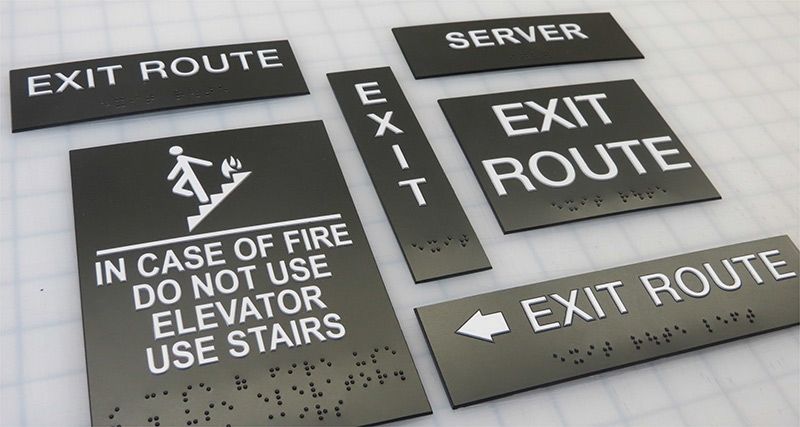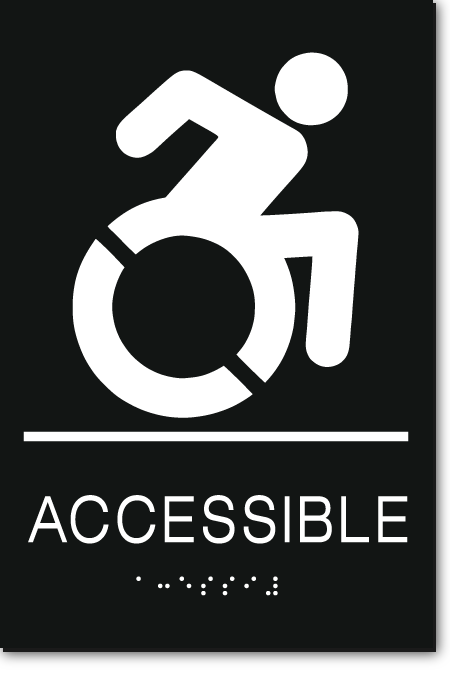Discover the Relevance of ADA Signs in Public Spaces
Wiki Article
Checking Out the Key Features of ADA Signs for Enhanced Accessibility
In the realm of accessibility, ADA signs work as quiet yet powerful allies, ensuring that spaces are inclusive and navigable for individuals with handicaps. By incorporating Braille and responsive aspects, these indications break obstacles for the aesthetically damaged, while high-contrast color pattern and understandable typefaces satisfy diverse aesthetic requirements. Their calculated placement is not approximate yet rather a computed effort to facilitate seamless navigation. Beyond these features exists a deeper narrative regarding the evolution of inclusivity and the continuous commitment to producing equitable rooms. What much more could these indicators symbolize in our search of global availability?Importance of ADA Compliance
Making sure conformity with the Americans with Disabilities Act (ADA) is vital for cultivating inclusivity and equivalent access in public spaces and offices. The ADA, enacted in 1990, mandates that all public facilities, companies, and transport solutions accommodate individuals with specials needs, guaranteeing they enjoy the exact same legal rights and opportunities as others. Compliance with ADA requirements not just meets lawful responsibilities but also boosts an organization's track record by showing its dedication to variety and inclusivity.One of the key facets of ADA conformity is the application of obtainable signs. ADA indications are made to make sure that people with disabilities can easily browse with areas and structures.
In addition, sticking to ADA policies can minimize the threat of lawful repercussions and possible penalties. Organizations that stop working to adhere to ADA guidelines may face legal actions or charges, which can be both harmful and financially troublesome to their public image. Hence, ADA compliance is indispensable to promoting a fair atmosphere for every person.
Braille and Tactile Aspects
The consolidation of Braille and responsive elements into ADA signage personifies the concepts of access and inclusivity. It is commonly placed below the matching message on signs to guarantee that people can access the details without visual support.Responsive components expand past Braille and consist of raised characters and symbols. These parts are made to be discernible by touch, allowing people to recognize area numbers, toilets, exits, and various other critical locations. The ADA establishes details standards pertaining to the dimension, spacing, and positioning of these tactile elements to enhance readability and ensure uniformity across different settings.

High-Contrast Color Pattern
High-contrast color schemes play a crucial function in boosting the exposure and readability of ADA signage for people with visual problems. These plans are necessary as they optimize the difference in light reflectance in between text and history, guaranteeing that signs are easily noticeable, even from a range. The Americans with Disabilities Act (ADA) mandates making use of certain shade contrasts to accommodate those with minimal vision, making it a vital aspect of compliance.The effectiveness of high-contrast shades hinges on their capacity to stand apart in numerous illumination conditions, including poorly lit environments and areas with glow. Normally, dark text on a light background or light message on a dark history is employed to achieve optimum contrast. Black text on a white or yellow history gives a raw visual distinction that helps in fast acknowledgment and comprehension.

Legible Fonts and Text Dimension
When taking into consideration the layout of ADA signs, the option of clear font styles and ideal message dimension can not be overstated. The Americans with Disabilities Act (ADA) mandates that fonts must be not italic and sans-serif, oblique, manuscript, extremely ornamental, or of unusual form.The dimension of the text also plays a pivotal duty in access. According to ADA standards, the minimum text height ought to be 5/8 inch, and it should raise proportionally with watching distance. This is especially important in public spaces where signage demands to be reviewed swiftly and precisely. Uniformity in text size contributes to a natural visual experience, aiding people in navigating settings effectively.
Furthermore, spacing in between letters and lines is essential to readability. Appropriate our website spacing prevents personalities navigate to this site from appearing crowded, boosting readability. By adhering to these requirements, designers can dramatically improve availability, guaranteeing that signs serves its designated objective for all individuals, despite their visual capacities.
Effective Placement Approaches
Strategic placement of ADA signs is necessary for making best use of ease of access and making sure conformity with legal standards. Effectively positioned indications assist people with disabilities effectively, promoting navigating in public spaces. Key factors to consider consist of elevation, exposure, and closeness. ADA guidelines state that indications must be installed at a height between 48 to 60 inches from the ground to ensure they are within the line of sight for both standing and seated individuals. This typical height variety is important for inclusivity, enabling wheelchair users and people of differing heights to accessibility details easily.In addition, signs have to be positioned adjacent to the lock side of doors to allow simple recognition before entrance. Consistency in indication placement throughout a center improves predictability, reducing complication and boosting general customer experience.

Final Thought
ADA signs play a crucial function in advertising ease of access by incorporating features that deal with the demands of people with specials needs. Integrating Braille and responsive components guarantees essential info is accessible to the aesthetically damaged, while high-contrast color design and readable sans-serif typefaces improve presence throughout various lighting conditions. Efficient placement methods, such as ideal placing elevations and strategic locations, even more help with navigating. These components jointly cultivate a comprehensive setting, emphasizing the significance of ADA compliance in making sure equivalent gain access to for all.In the realm of ease of access, ADA signs offer as quiet yet powerful allies, making sure that rooms are comprehensive and accessible for individuals with specials needs. The ADA, passed in 1990, mandates that all public centers, employers, and transport services accommodate individuals with impairments, ensuring they take pleasure in the same civil liberties and opportunities as others. ADA Signs. ADA signs are designed to guarantee that people with specials needs can easily browse via rooms and structures. ADA guidelines specify that indicators need to be mounted at an elevation in between 48 to 60 inches from the ground to ensure they are within the line of view for both standing and seated individuals.ADA indications play an essential role in promoting access by integrating discover this info here features that address the needs of individuals with impairments
Report this wiki page